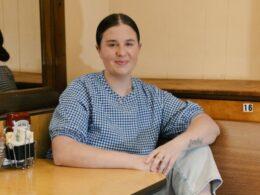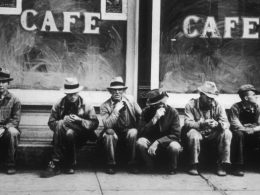A fledgling avocado plant stands on an aluminium console in the living room of Șerban Ionescu’s Paris apartment, its roots twisting down into a glass carafe, a spindly stem stretching up to spread a handful of leaves. The artist sees it as a good omen.
“We couldn’t get one going at all in Brussels,” says Ionescu, who moved from the Belgian capital with his wife, the cinematographer Bérénice Eveno, and two daughters six months ago. “Then we came here. It was from one of the first avocados that we ate. It’s a nice metaphor — it feels like this is a place where we can grow.”
Ionescu has become celebrated for his vibrant, playful — and functional — sculptures in ceramic, wood and powder-coated steel. Often, they have faces with wonky smiles, at once comic and creepy. He recently installed a 33ft public sculpture named “Room for a Shroom” in Zonhoven, Belgium. Brand collaborations include those with Hermès. Following exhibitions that have ping-ponged him across the globe — from Louise Alexander Gallery in Sardinia to Akiinoue in Tokyo and R & Company in New York — he is about to open a solo show at Marta, Los Angeles.
Such ricocheting in some ways echoes Ionescu’s personal life, but recently, finding somewhere he and his family could put down roots has become increasingly important.
Born in Romania, Ionescu had moved to New York when he was 10, growing up, studying and forging his career there. But he and his family had spent the pandemic in Toronto, where Eveno was working on the television series The Handmaid’s Tale, and when they made it back to New York, to their apartment in Red Hook, in Brooklyn, they found it was different to how they remembered it: “It felt like the energy of the city had shifted, and something had changed in me,” he says. “I never thought I would leave New York, but we had our second daughter and we were out-roomed in our apartment. From that, this wanderlust emerged.”
They tried Brussels first, as Ionescu had an exhibition and commissions in the city. They stayed for 18 months, shuttling back and forth to New York, but Paris — where Eveno grew up — won out in the end. “Brussels was a good way to land in Europe, we made great friends, but every time I’d get off the train at [Paris’s] Gare du Nord, I’d feel like I was in a bustling city again,” he says.

It’s for this reason that Ionescu describes Paris as “New York 2.0”: it’s a place that he finds inspiring and invigorating. New York had shaped him, personally and artistically. “I think my quickness, the way I draw, the way I think, the way I speak, my energy, I think all of that really emerged out of the quickness of New York, the sloppiness, the chaos of it.” As an architecture student at Pratt Institute, he would collaborate with the other students, experimenting with new ideas in their apartments. But after graduating he decided to focus on drawing, painting and sculpture.
It wasn’t until some years later, when he was creating furniture for his apartment in an abandoned building in Red Hook (alongside installing plumbing and electricity and a window with a view of the Statue of Liberty) that he found a way to reconcile his interests in art, architecture and design. “All of a sudden, I found that building something for the house, which didn’t have the stakes of an exhibition at a gallery, allowed me to almost be complete,” he says. “It felt much rougher, cruder, but it also came without judgment, it had no critical desires. And then once people saw it, it snowballed.”


The home continues to be a place of experimentation for Ionescu, even if making the Paris apartment habitable was far more straightforward than it was in Red Hook. The apartment they found hidden amid a warren of historic buildings in the 11th arrondissement is a rental and needed little work. The ground and first floor of a well-maintained late 19th-century building — with its high ceilings, crown mouldings, marble fireplace, private garden and studio — is a refined backdrop for his and Eveno’s collection of furniture and artwork (at least for now, plans for more extensive interventions are in the works).
They sent two palettes from New York that contained “predominately just the art collection” — works by friends in New York including Clayton Schiff, Carlos Little, Eliot Greenwald and Omari Douglin that now line the stairs. The furniture, some shipped over from New York, some acquired in Europe, was quickly “collaged” together, he says.
Ionescu knocked up the kitchen a few days before the family moved in. In the dining room, which is open to the kitchen and the living room, there is a table base by Belgian architect and designer Theo De Meyer — who also made the ceiling lights — with a tabletop by Bel Albatros, a company in Brussels that recycles the city’s plastic waste to create custom designs.

Ionescu’s playful approach is evident everywhere: on the walls of the ground-floor toilet hang masks from Japan, Romania and Mexico, and a wooden chopping board found in a market in Provence that inspired a colourful chair in the hall — its wide, triangular handle reimagined as a face.
The first floor is a little more restrained. A curtain covers one wall in Ionescu and Eveno’s bedroom, hiding their closet. Ionescu points out how the bedrooms look out on to mature trees — “there’s almost a sea of green in summer”. The house faces an identical building, as if on a quiet provincial road and not tucked away in a hectic city.
In contrast to Ionescu’s vibrancy, Eveno’s office is a deliberately minimal refuge: “It’s funny, she wanted not to do colour.”


Ionescu says he never expected to find somewhere like this in Paris, where his daughters can play with the neighbours’ children in the tranquil garden where he has installed his work. “Once we did, it felt like the guards were down a bit,” he says.
Another important factor in the house — and even the move to Paris — was the studio. “It’s the smallest studio I’ve ever had,” he says. “I still have my studio in New York, which is maybe three or four times larger than this, but then I think it was Leonardo da Vinci who said small rooms discipline the mind.” It is large enough, at least, for him to have made a “pretty huge” installation of red and green sculptures for the windows of Hermès’s store in Amsterdam.

Having the studio so close to home was a natural step, given how closely intertwined his practice has become with the home. “In New York, I was always moving closer to the studio,” he says. “Now the house has become the studio, it’s all this one blurred zone.”
In the long term, he hopes the apartment will nurture more than just an avocado plant. “I’m hoping to build a community here,” he says. “I want the studio and my modest garden to turn into a space that’s exciting for people to visit.”
“The Great Outdoors” at Marta, Los Angeles, April 19-May 31; marta.la
Find out about our latest stories first — follow @ft_houseandhome on Instagram









